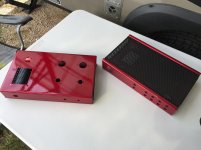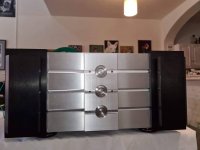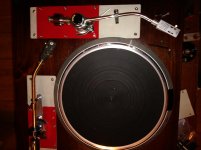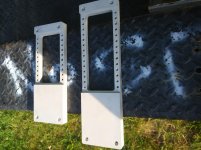Having finished my own aluminum, I've concluded that the easiest and most elegant finish is to wet sand it up to at least 800 and shoot it with flat black enamel. And then wet sand the paint. Reason being, it ages better than anything else. I'm sure there are some raw finish techniques that are pretty cool and quite striking, but inevitably that all oxidizes into something flat in their own right. I've dressed mine up with a mirror polished front panel. Nice and shiny.
Last edited:
Its been a while since I created this thread, but I'm making some chassis now. I went around and around deciding what alloy of aluminum I liked best since I am doing bends to form the front and rear panels. 6061 has a much too hard of temper for bending so I settled on 3003 alloy. The 3003 also cuts up better in my CNC machine (which is really made for wood, but can handle aluminum). As for the finish, I have always had a love affair for bare aluminum or anodized aluminum uncolored. I love the look of the old Sansui aluminum face receivers of the 70's.
As for finish I tried many different things... But for ease of getting a job done in a reasonable amount of time I've settled on this:
I orbital sand the plate (before bending and after cutting with 800 grit. I go direct to 800 because I found starting with a courser grit left too much scratches that I had to just get rid of with 800 anyway. I sand the hell out of it with 800 for a fairly long time to ensure its consistent. Its also important to pull the sander off the work flat, not tilted or it will leave a scuff. After the sanding session with 800 I wipe off the work with paper towel. Then I put a scotch bright disk on my sander (a 5.5 inch random orbital) and I buff it well with scotch bright. This last step really gives me the patina I want! The Scotch Bright pad "dulls out" all the 800 grit patina and leaves it with a nice pearl finish I'm after. I did try going to 1200 grit in my trials but found that I could not get a pearl-like finish, 1200 grit begins to approach a mirror finish which I dont want. Right now I'm not anodizing nor am I putting on Cerakote clear for protection. Just going raw to see how it holds up. If I find that its not durable enough I may use Cerakote on other projects.
When I get more examples I'll post a photo.
As for finish I tried many different things... But for ease of getting a job done in a reasonable amount of time I've settled on this:
I orbital sand the plate (before bending and after cutting with 800 grit. I go direct to 800 because I found starting with a courser grit left too much scratches that I had to just get rid of with 800 anyway. I sand the hell out of it with 800 for a fairly long time to ensure its consistent. Its also important to pull the sander off the work flat, not tilted or it will leave a scuff. After the sanding session with 800 I wipe off the work with paper towel. Then I put a scotch bright disk on my sander (a 5.5 inch random orbital) and I buff it well with scotch bright. This last step really gives me the patina I want! The Scotch Bright pad "dulls out" all the 800 grit patina and leaves it with a nice pearl finish I'm after. I did try going to 1200 grit in my trials but found that I could not get a pearl-like finish, 1200 grit begins to approach a mirror finish which I dont want. Right now I'm not anodizing nor am I putting on Cerakote clear for protection. Just going raw to see how it holds up. If I find that its not durable enough I may use Cerakote on other projects.
When I get more examples I'll post a photo.



